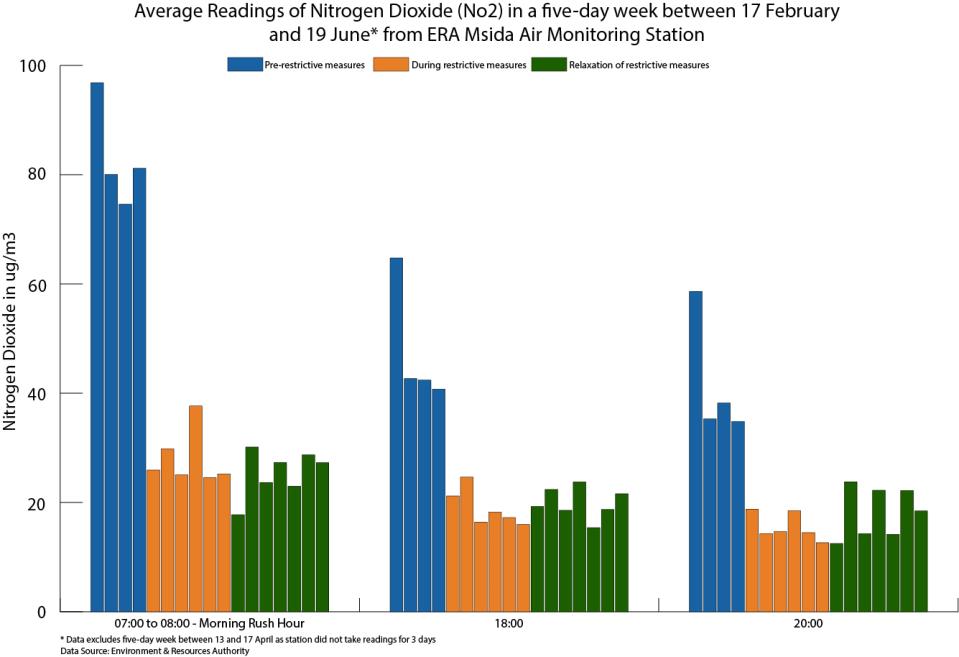In what may be a glimmer of hope, air pollution levels have remained low even as Covid-19 restrictions are being lifted, data analysed by The Malta Independent on Sunday shows.
An analysis of four months of data readings from the Environment & Resources Authority (ERA) air monitoring station in Msida – usually one of Malta’s busiest junctions – shows how even now that restrictions have started to be lifted, the level of pollutants traditionally associated with car use have remained similar to what they were back in mid-March, when restrictions were first introduced.
Mitigation measures and closures to reduce the spread of Covid-19 were introduced in mid-March.
Schools, Universities, and child care centres were closed as of 13 March, the closure of bars, restaurants, and gyms followed three days later, while the airport was slammed shut on 20 March. Non-essential retail outlets were closed as from 23 March, while group gatherings were limited to three people a week later.
The first of these measures started to be relaxed in May, with some non-essential outlets being allowed to welcome customers again on 4 May. Restaurants, hairdressers, beauty salons, and a number of health services and clinics re-opened on 22 May in the second batch of relaxation measures announced by the government. The third set, announced on 1 June, will saw the remaining establishments – including bars and gyms – allowed to open their doors again as from 5 June. The airport will open on 1 July to certain countries, before opening fully on 15 July.
The Malta Independent on Sunday reported in March – a week after restrictions started to be introduced – that there was a big decrease of up to some 70% in air pollutants in the country as soon as restrictions were introduced.
Chief amongst those pollutants is Nitrogen Dioxide (NO2) – a pollutant which, according to the World Health Organisation, comes from “power generation, industrial and traffic sources”, and which is being increasingly linked to bronchitis, asthma, and respiratory infections which affect both the heart and lungs.

Graph comparing the readings shows an indication of a slight increase in pollutants in the 8pm time frame after restrictions were being relaxed
This newspaper took a five-day week average for Nitrogen Dioxide during the period between 17 February and 19 June – with the exception of the weekdays between 13 and 17 April, when the ERA’s monitoring station did not take readings for a couple of days – with readings at three particular timestamps: the morning rush hour period between 7am and 8am; 6pm; and 8pm.
The readings taken in the first five-day week between 17 and 21 February – over two weeks before the first case of Covid-19 was found in Malta on 7 March – were the highest: an average of 96.837 micrograms per cubic metre (ug/m3) at the morning rush hour, 64.749 ug/m3 at 6pm, and 58.637 ug/m3 at 8pm.
In the following three weeks, which was still before restrictions had been put in place, the numbers had dropped to around 80 ug/m3 in the morning, 42 ug/m3 at 6pm, and 35 ug/m3 at 8pm.
The five days between 16 and 20 March – the week when restrictions were introduced – was the first to represent a major drop, with an average of 25.938 ug/m3 detected in the morning, 21.198 ug/m3 at 6pm, and 18.794 ug/m3.
Three months have elapsed since then. With restrictions now being lifted, it was somewhat expected that the levels of pollutants in the air would once again start to increase.
However, so far, the level of Nitrogen Dioxide has remained very similar to those recorded in the first five-day week when measures were introduced.
The highest average recordings at each respective timeframe throughout the last three months was of 37.665 ug/m3 (average recorded between 6 and 10 April) in the morning, 24.639 ug/m3 (average recorded between 23 and 27 March) at 6pm, and 23.798 ug/m3 (average recorded between 11 and 15 May) at 8pm.
The recordings for between 15 and 19 June – last week – show that an average of 27.275 ug/m3 of Nitrogen Dioxide was detected in the morning period, 21.583 ug/m3 at 6pm, and 18.451 ug/m3 at 8pm.
When comparing these averages to the same averages taken in the last week before restrictive measures were put in place – that being between 9 and 13 March – the morning readings are still 66% less this week, while the 6pm and 8pm readings are both 47% less this week as well.
However – why is this still only a glimmer of hope rather than a full ray of sunshine coming through a smog-less sky?
There are still some variables which mean that the situation today differs with that last March. Chief amongst those is the fact that the airport and cruise port remain shut. The polluting capabilities of aircraft and, more so, cruise liners, is well known, while this also means that there is no tourist related traffic on the roads as well.
Another important variable is that schools are still all closed as well. This coupled with the fact that a number of businesses are still using some form of teleworking system – be it with all employees still working from home, or only some working from home on a roster basis – affects the pollution morning rush hour traffic in particular.
Many have called for the post-Covid 19 so-called ‘new normal’ to be a more environmentally friendly normal than the pre-Covid 19 period. An integral part of this would, no doubt, be the reduction of air pollutants through the reduction of travel.
It remains to be seen now, in the coming months, for how long these low pollution levels can be preserved.